Interdisciplinary methodological approach to the process of brownfield revitalisation of traditional industrial areas
DOI:
https://doi.org/10.18690/rg.6.1.3791Keywords:
applied geography, interdisciplinary methodological approach, endogenous approach, practice tools, brownfield revitalisationAbstract
Traditional industrial regions in the South-East Europe (SEE) represent an underexplored economic value. Revitalisation is delayed and hindered because of legal, financial, environmental and image problems. This weakens competitive investment position for cities and for SEE as a European region. This paper aims at presenting interdisciplinary methodological approach used in a brownfield revitalisation research project. The research work methodology applies the endogenous approach (“bottom up”) on a basis of newly defined land use category of brownfields by the local community. Geography science enjoys an advantage of complexity of understanding spatial issues. This enables geographers to coordinate and harmonize interests between the owners, stakeholders, legislation and human resources. In addition to geographical areas (economic, traffic, demographic, environmental and regional geography) directly involved in the project applicative research, this also includes collaboration of architects, lawyers and economists. The form of applicative research work presented is being developed within the international Revitalisation of Traditional Industrial Areas in South-East Europe (ReTInA) project. The project is funded in the context of the SEE European Transnational Cooperation Programme 2009/12, involving ten partners from seven countries. The main result of the project will be the new methodology and tools to boost brownfield revitalisation in the municipalities and in old industrial areas of SEE region.
Downloads
References
Auer, M.R., Reuveny, R. 2001: Foreign Aid and Foreign Direct Investment : Key Players in the Environmental Restoration of Central and Eastern Europe, FEEM Fondazione Eni Enrico Mattei, Research Paper NO. 58.2001, Social Science Research Network Electronic Paper Collection: http://papers.ssrn.com/abstract=278811
Domanski, B. 2000: The Impact of Spatial and Social Qualities on the Reproduction of Local Economic Success: The Case of the Path Dependent Development of Gliwice, Prace, Geograficzne, fas.106, Krakow, 2000.
Estrin, S., Meyer, E.K. 2009: Brownfield Acquisitions: A Reconceptualization and Extension, Working paper, http://dx.doi.org/10.2307/23012289
Frej, A., et al., 2001: Business Parks and Industrial Development Handbook. Washington, D.C.: ULI-the Urban Land Institute.
Gray, A. 2007: A Sustainable Evaluation Process for Brownfield Sites, Procedings 2nd International Conference on Managing Urban Land, Stuttgart, Germany
Ionescu-Heroiu, M. 2010: The Management of Brownfields Redevelopment, A Guidance Note, World Bank, Europe and Central Asia Region, Sustainable Development Department
Lorber, L. 2006a: Development of the industrial areas of Maribor and change of their intended function. V: MAIER, Jörg (ur.). Stadt und Stadtregion Maribor : Strukturen, Entwicklungen, Probleme, (Arbeitsmaterialien zur Raumordnung und Raumplanung, Hft. 250). Bayreuth: Universität, Lehrstuhl Wirtschaftsgeographie und Regionalplanung.
Lorber, L. 2006b: Functional changes in Tezno, the industrial zone in Maribor. Revija za geografijo, 2006, 1, št. 2, str. 95-108, ilustr. https://doi.org/10.18690/rg.1.2.2893
Lorber, L. 2010: New perspective of the regional development of old industrial areas,
Sjezd České geografické společnosti, Ostrava 2010, 31. srpna - 3. zaří, 2010. "Geografie pro život ve 21. století" Ostrava: Ostravská univerzita v Ostravě, http://konference.osu.cz/cgsostrava2010/31_sbornik-prispevku.html
Neonato, F. 2005: Job Vacancy – Process Manager Needed. Professional Skills for Brownfield Regeneration, CABERNET Position Paper – Professional Skills in Brownfield Regeneration 1st Edition – April 2005 http://dx.doi.org/10.13140/RG.2.1.2163.8881
Ptáček, P., Szczyrba, Z. 2007: Current suburbanisation trends in the Czech Republic and spatial transformation of retail, Journal for Geography, 1-2, 2007, p.55-66, Maribor https://doi.org/10.18690/rg.2.1.2902
Sitar, M. 2008: Maribor - housing strategies in a Slovenian city linking competitiveness with social cohesion. V: ACHE, Peter (ur.). Cities between competitiveness and cohesion : discourses, realities and implementation, (The GeoJournal library, 93). [Dordrecht]: Springer, https://doi.org/10.1007/978-1-4020-8241-2_10
Sitar, M., Lorber, L., Šubic Kovač, M. 2011: Revitalized Industrial Zones in the Context of Sustainable Urban Land Development in Slovenia: the Case of Business and Industrial Zone Tezno, Maribor, V: Tira,M., Ivanička, K., Špirková K.,(ed.). Industrial Urban Land Redevelopment, Cost Action TU0602, Land Management for Urban Dynamics, (in print).
Transnational Cooperation EU Programme in the project Revitalisation of Traditional Industrial Areas in South-East Europe (ReTinA), Working paper, Budimpešta, 2008.
Umar, 2005: Ciljni razvojni scenarij Strateškega razvoja Slovenije,
http://www.umar.gov.si/fileadmin/user_upload/publikacije/dz/2005/dz12-05.pdf
UM a. 2009: Guidelines for Methodology of the Work of Task Forces, University of Maribor.
UM b. 2009: Regional Case Studies, Needs Analysis Guidelines, University of Maribor and Province Ferrara.
UM a. 2010: Regional Case Studies, University of Maribor, Faculty of Arts, Working paper, WP3 responsible | University of Maribor, WP4 responsible | Province of Ferrara
UM b. 2010: SWOT Analyses BIC Tezno, University of Maribor, Faculty of Arts, Working paper,
Vlada RS. 2006 : Operativni program za krepitev regionalnih razvojnih potencialov,
NET 1: www.cabernet.org.uk/index.asp?c=1134
NET 2: http://www.commonforum.eu/Documents/DOC/Clarinet/brownfields.pdf
NET 3: Rescue, Methodology, august 25, 2003
http://web.archive.org/web/20041020143929/www.rescue-europe.com/download/res_proj.pdf
NET 4: Cabernet net work report, http://www.cabernet.org.uk/resourcefs/427.pdf
Downloads
Published
Issue
Section
License
Copyright (c) 2011 Lučka Lorber

This work is licensed under a Creative Commons Attribution 4.0 International License.
